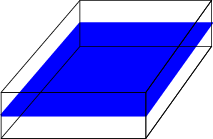
In a square, heat-conducting sheet, insulated from above and below
|
{1\over
k} {∂u\over
∂t} = {{∂}^{2}u\over
∂{x}^{2}} + {{∂}^{2}u\over
∂{y}^{2}} .
| (5.29) |
If we are looking for a steady state solution, i.e. we take u(x,y,t) = u(x,y) the time derivative does not contribute, and we get Laplace’s equation
|
{{∂}^{2}u\over
∂{x}^{2}} + {{∂}^{2}u\over
∂{y}^{2}} = 0,
| (5.30) |
an example of an elliptic equation. Let us once again look at a square plate of size a × b, and impose the boundary conditions
(This choice is made so as to be able to evaluate Fourier series easily. It is not very realistic!) We once again separate variables,
|
u(x,y) = X(x)Y (y),
| (5.32) |
and define
|
{X''\over
X} = −{Y ''\over
Y } = −λ.
| (5.33) |
Or explicitly
|
X'' = −λX,\kern 2.77695pt \kern 2.77695pt Y '' = λY.
| (5.34) |
With boundary conditions X(0) = X(a) = 0, Y (0) = 0. The 3rd boundary conditions remains to be implemented.
Once again distinguish three cases:
λ > 0
X(x) =\mathop{ sin}\nolimits {α}_{n}(x),
{α}_{n} = {nπ\over
a} ,
{λ}_{n} = {α}_{n}^{2}. We
find
Since Y (0) = 0
we find {D}_{n} = 0
(\mathop{sinh}\nolimits (0) = 0,\mathop{cosh}\nolimits (0) = 1).
λ ≤ 0 No
solutions
So we have
|
u(x,y) ={ \mathop{∑
}}_{n=1}^{∞}{b}_{
n}\mathop{ sin}\nolimits {α}_{n}x\mathop{sinh}\nolimits {α}_{n}y
| (5.36) |
The one remaining boundary condition gives
|
u(x,b) = x ={ \mathop{∑
}}_{n=1}^{∞}{b}_{
n}\mathop{ sin}\nolimits {α}_{n}x\mathop{sinh}\nolimits {α}_{n}b.
| (5.37) |
This leads to the Fourier series of x,
So, in short, we have
|
V (x,y) = {2a\over
π} {\mathop{∑
}}_{n=1}^{∞}{(−1)}^{n+1}{\mathop{sin}\nolimits {nπx\over
a} \mathop{ sinh}\nolimits {nπy\over
a} \over
n\mathop{sinh}\nolimits {nπb\over
a} } .
| (5.39) |
Question: The dependence on x enters through a trigonometric function, and that on y through a hyperbolic function. Yet the differential equation is symmetric under interchange of x and y. What happens?
Answer: The symmetry is broken by the boundary conditions.